新概念英语第三册连词、介词、数词课件(共81张PPT)
文档属性
| 名称 | 新概念英语第三册连词、介词、数词课件(共81张PPT) |
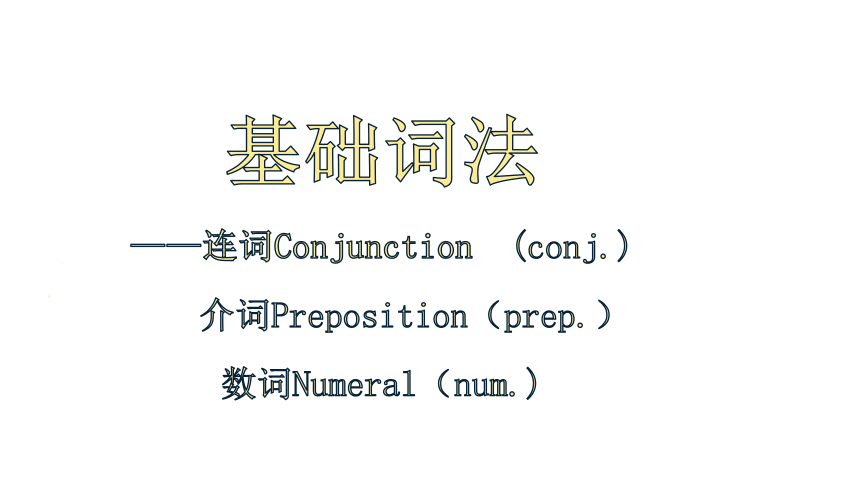
|
|
| 格式 | pptx | ||
| 文件大小 | 3.0MB | ||
| 资源类型 | 教案 | ||
| 版本资源 | 新概念英语 | ||
| 科目 | 英语 | ||
| 更新时间 | 2025-05-21 07:27:05 | ||
图片预览




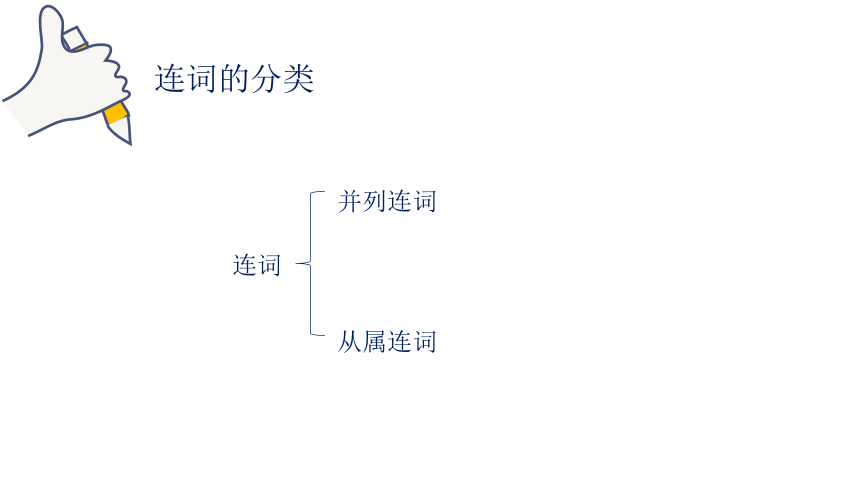

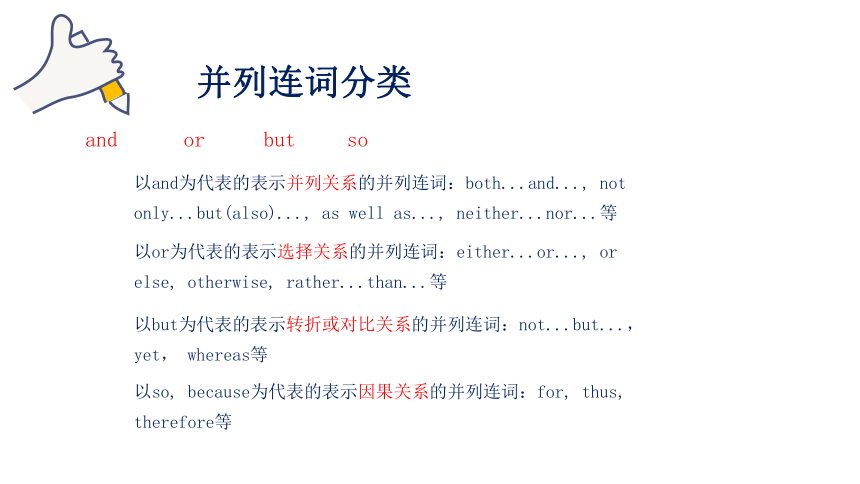
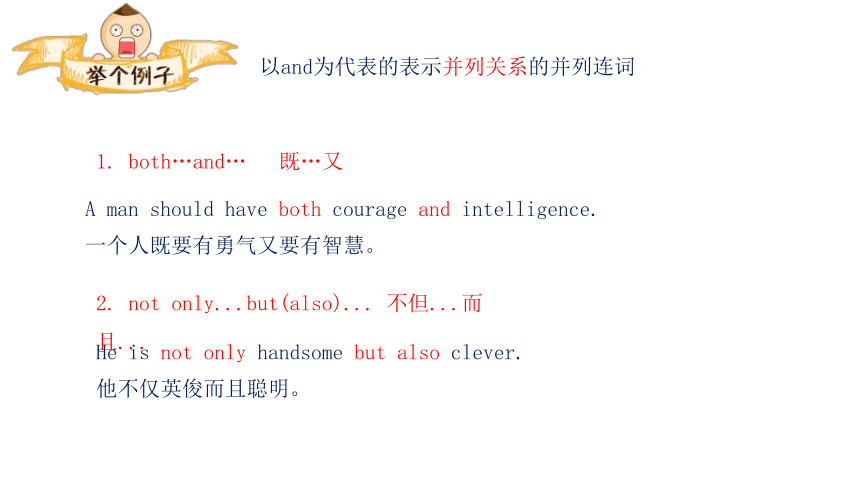
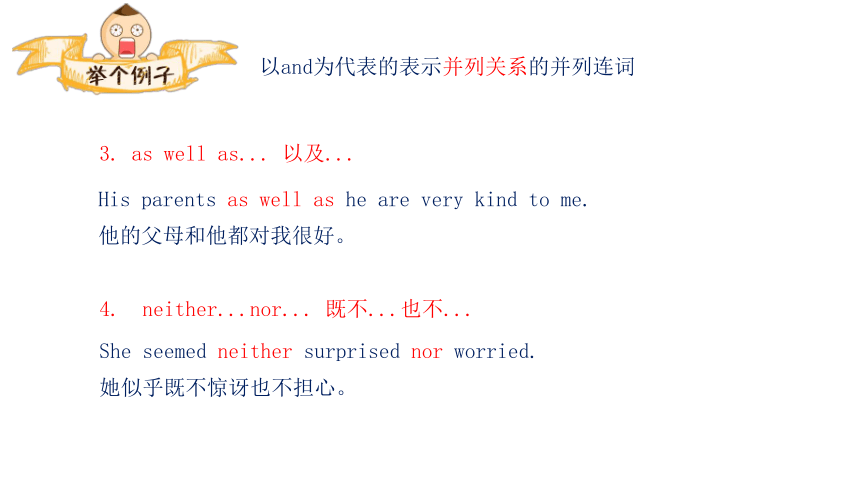
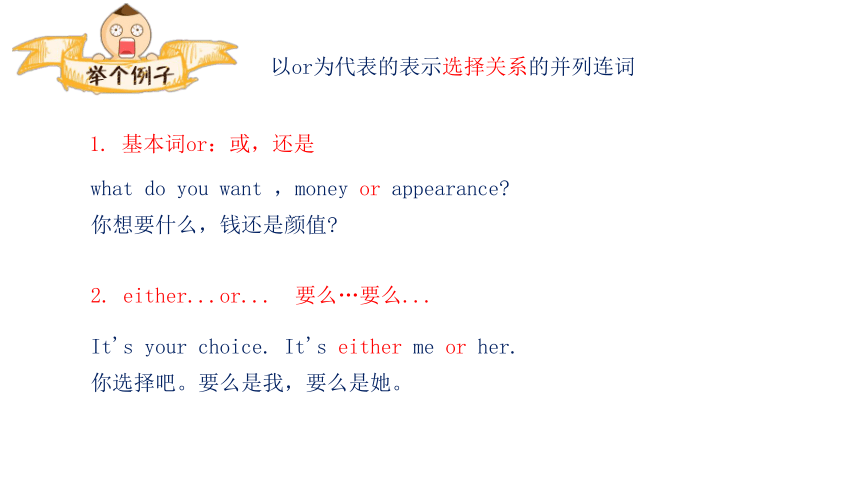
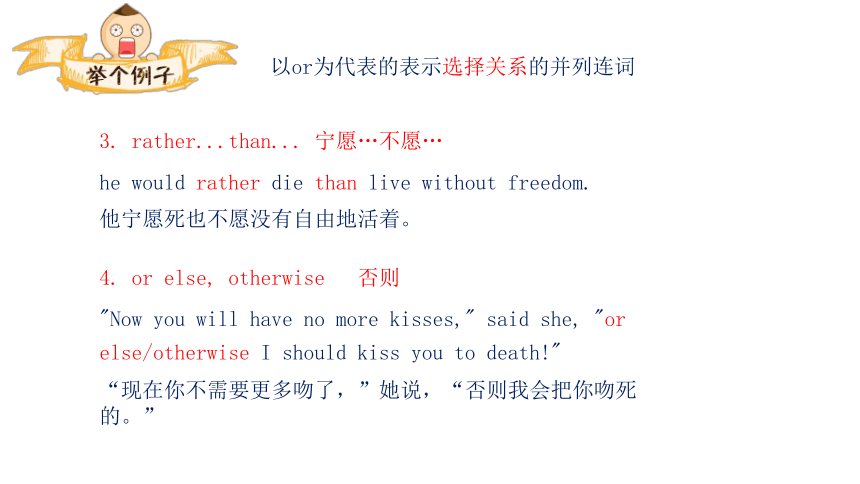
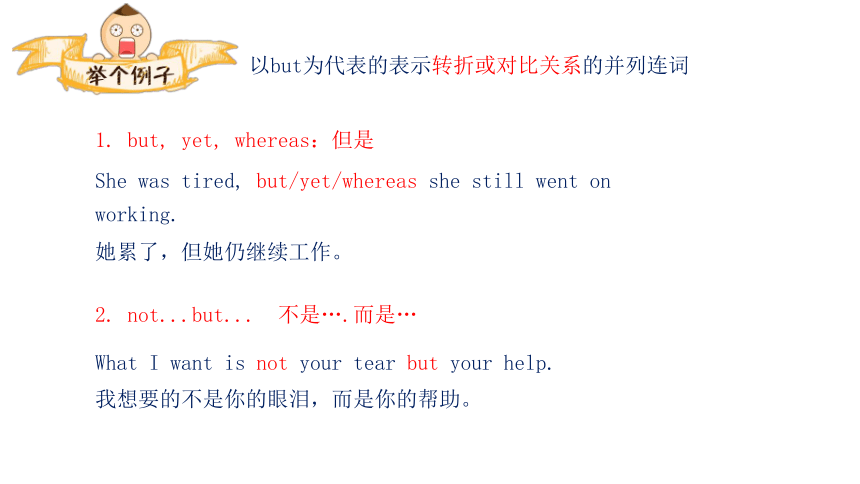
文档简介
(共81张PPT)
基础词法
——连词Conjunction (conj.)
介词Preposition(prep.)
数词Numeral(num.)
知识框架
连词的分类
常用连词
用法辨析
介词的分类
常用介词
用法辨析
介词短语
数词分类
数词的用法
连词的分类
1
一、连词的分类
什么是连词?
连词是一种虚词,不能独立担任句子成分,不可独立使用,在句中起连接词与词、短语与短语、句子与句子的作用。
无私奉献
粘合剂
虚词,不做
句子成分
连接两个词/短语/句子
连词的分类
连词
并列连词
从属连词
并列连词
并列连词连接平行或并列的词、词组和分句,构成平行或并列结构。
连词所连接的单词和单词,短语和短语,
句子和句子之间的性质和成分(句法功能)都相同。
My friend and I love to eat delicious food.
主语
主语
并列连词分类
and
or
but
以and为代表的表示并列关系的并列连词:both...and..., not only...but(also)..., as well as..., neither...nor...等
以or为代表的表示选择关系的并列连词:either...or..., or else, otherwise, rather...than...等
以but为代表的表示转折或对比关系的并列连词:not...but...,yet, whereas等
so
以so, because为代表的表示因果关系的并列连词:for, thus, therefore等
1. both…and… 既…又
2. not only...but(also)... 不但...而且...
A man should have both courage and intelligence.
一个人既要有勇气又要有智慧。
以and为代表的表示并列关系的并列连词
He is not only handsome but also clever.
他不仅英俊而且聪明。
3. as well as... 以及...
His parents as well as he are very kind to me.
他的父母和他都对我很好。
4. neither...nor... 既不...也不...
She seemed neither surprised nor worried.
她似乎既不惊讶也不担心。
以and为代表的表示并列关系的并列连词
2. either...or... 要么…要么...
It's your choice. It's either me or her.
你选择吧。要么是我,要么是她。
1. 基本词or:或,还是
what do you want ,money or appearance
你想要什么,钱还是颜值
以or为代表的表示选择关系的并列连词
3. rather...than... 宁愿…不愿…
he would rather die than live without freedom.
他宁愿死也不愿没有自由地活着。
4. or else, otherwise 否则
"Now you will have no more kisses," said she, "or else/otherwise I should kiss you to death!"
“现在你不需要更多吻了,”她说,“否则我会把你吻死的。”
以or为代表的表示选择关系的并列连词
1. but, yet, whereas:但是
She was tired, but/yet/whereas she still went on working.
她累了,但她仍继续工作。
2. not...but... 不是….而是…
What I want is not your tear but your help.
我想要的不是你的眼泪,而是你的帮助。
以but为代表的表示转折或对比关系的并列连词
1. 基本词so:所以
2. because/ for... 因为
He was angry, so he could not speak.
他生气了,所以说不出话来。
I could not visit you , because / for I felt very tired today.
我不能去看你了,因为今天我感觉很累。
以so, because为代表的表示因果关系的并列连词
3. therefore,thus 因此…
She worked hard, therefore/thus she got high scores.
她学习努力,因此得了高分。
以so, because为代表的表示因果关系的并列连词
Practice It!
In that part of the desert we couldn’t see_________ plant_________ animals.
A. neither, nor
B. either, or
C. both, and
D. no, also
从属连词
连接两个或两个以上的简单句的词
从属连词
简单从属连词
复合从属连词
You should stop bothering me when I'm working.
主句
从句
关联从属连词
简单从属连词:单个单词
引导名词性从句:whether(是否),whatever(无论什么),that,who/whom(谁)、what(什么)...
引导状语从句:after(在……以后)、before(在……之前)、since(自从)、once(一……就)、till/until(直到……为止)、if(如果)、unless(除非)、lest(以免)、while(与……同时)
引导定语从句:when(什么时候)、where(什么地方)、why(为什么)、whose(谁的)、which(哪一个)...
I can’t leave him unless I know he’s all right.
I haven’t played basketball since I left university.
除非知道他没事,否则我不能离开他。
我大学毕业后就没打过篮球。
Once I get her a job, she’ll be fine.
一旦我帮她找到了工作,她就会好的。
复合从属连词:多个单词复合
as soon as(一……就)、as far as(就……而言)、
as long as(只要)、
no matter (when/what/where/who…)(不管……)、as if(似乎)、in order that(为了)、so that(所以)、now that(既然)、provided that(假如)
...
As soon as Mark got inside, the dog shook himself.
She left early in order that she would arrive on time.
马克一进来,狗就开始摇头摆尾。
她早早出发好按时到达。
We will go even if it rains.
即使下雨,我们也要去。
关联从属连词:两个关联词构成
so/such...that... 如此......以致于......
no sooner...than... 一......就......
hardly/scarcely...when... 一......就......
the more...the more... 越......越......
We had no sooner gone out than it began to rain.
She has such good taste that her friends all ask her for fashion advice.
我们刚走到外面就开始下雨了。
她的品味如此好以至于她的朋友们都向她征求时尚方面的建议。
Practice It!
They decided to chase the cow away______ it did more damage.
A. unless
B. until
C. before
D. while
Practice It!
You can borrow my book,______ you promise to give it back to me by the end of this month.
A. as far as
B. as soon as
C. as long as
D. as well as
常用连词用法辨析
2
no sooner…than、hardly…when…(刚……就)
He had no sooner/hardly sat down than/when he said that he had to leave.
他刚坐下就说他得走了。
主+had+no sooner/hardly done...than/when+主+did...
常用连词用法比较
unless “除非” 与if...not “如果不”
We will visit the Great Wall tomorrow unless it rains.
= If it doesn't rain tomorrow, we'll visit the Great Wall.
遇到使用unless的句子时,弄不清该用肯定还是否定时,将unless替换成if...not的结构即可
肯定
常用连词用法比较
so...that...与such...that...
so + 形容词/副词 + that从句
so+形容词+ an/a +单数可数名词+ that 从句
so + many/few +可数名词复数+ that 从句
so + much/little + 不可数名词+ that 从句
many,few,much,little表示数量多少时,只能与so连用。
常用连词用法比较
such + a/an +形容词+单数可数名词+ that 从句
such +形容词+可数名词复数+ that 从句
such +形容词+不可数名词+ that 从句
He is such a smart boy that all us think highly of him.
= He is so smart a boy that all us think highly of him.
so...that...与such...that...
常用连词用法比较
till / until 用于肯定句中, 常与表示连续性的动词连用
“直到......为止“
not …till/until, 常与表示短暂性动词连用
“直到......才”
I will stay here until you come back.
I hadn’t realized she was foreign until she spoke.
till和until
常用连词用法比较
介词的分类
3
介词定义
介词是一种虚词,不能单独作为句子成分,通常用在名词或代词之前,置于介词后的动词,需使用动名词(v-ing)形式。
一个介词有多个意思
B
复合介词
C
双重介词
D
分词介词
E
短语介词
A
简单介词
单一介词
两个单一介词合成
两个简单介词连在一起
部分动词的分词形式
一个或几个简单介词和一个或几个其他此类组合
介词的分类
about, above, after, against, among, around,at,
before, behind, beside, besides, between, by, despite, during, except, for, from, in, into, like, near, of, off,
on, over, past, since, than, through, till, to, under, until, unlike, up, with...
单一介词
简单介词
alongside, beside,inside , into , onto, outside , throughout(遍及,到处), upwards, downwards, afterwards(后来),upon(=on), within, without...
两个单一介词合成
复合介词
as from(从......起......) , as for (至于) , over against(与......相反) , except for(除了......以外), but for(要不是), from among(从......中) , from behind , from under, inside of, outside of, until after(直到……结束之后为止)...
两个简单介词连在一起
双重介词
concerning(关于), considering/considered(考虑到;鉴于), excluding(除......外), following(在......之后), including(包含), regarding(关于), providing/provided(倘若,假如)...
部分动词的分词形式
分词介词
according to(根据,按照),along with(和......一起),because of(因为),by means of(依靠,借助于),due to(因为),instead of(而不是)...
一个或几个简单介词和一个或几个其他此类组合
短语介词
B
地点介词
C
原因介词
D
条件介词
E
比较介词
A
时间介词
F
其他介词
in , on ,at, about, after, before, by, during, from, for, until, since
in, on, at, above, among, behind, below, beside,
between, from, into, near, through, under, up
because of, for, at, with
but for, considering, in case of
as, like, than, to
about, on, of, with, without, except, besides,
instead of, but
介词的分类
常用介词用法辨析
4
介词in
The bird is in the box.
1. 表示“在……里面”或“在......其中(包含在......之内)”
There are 31 days in May.
2. in其后可加语言,表示“用某种语言”或“在某种语言里”。
He answered my questions in English.
There are some exotic words in French.
/ ɡ z t k/ 外来词
时间:at,in,on
1. at用法
(1)表示时间点、时刻等,如 at 12: 00 , at noon , at night , at midnight , at dawn/ daybreak (在黎明/破晓) , at sunrise/ sunset (在日出/日落) , at dusk (在黄昏)
(2)表示较短暂的一段时间,可指某个节日或被认为是一年中标志大事的日子,如 at Christmas (在圣诞节)
常用的时间介词
2. in用法
(1) 表示在某段较长的时间内(例如:世纪、朝代、年代、月份及泛指上午、下午和傍晚等)
in the 1980 ’ s/1980s, in the Qing Dynasty, in October, in the morning/afternoon/ evening 这里的“上午、下午和
晚上”是泛指
时间:at,in,on
常用的时间介词
2. in用法
(2) 表示“在......之后”,后面接一段时间,多用于将来时
in two days 两天之后
We are going to Beijing in two weeks.
我们两周后去北京。
时间:at,in,on
常用的时间介词
3. on用法
(1)用于表示具体的某一天或一个特定的时间(例如:某日、某节日、星期几等)
e.g. on May 1st, on a rainy day, on National Day
(2)准时,按时: on time
及时:in time
时间:at,in,on
常用的时间介词
3. on用法
(3)用于表示特定的上午、下午或晚上
on Christmas Eve (在圣诞节前夕) , on the morning of
January 3rd 这里的“上午和下午”是特指
时间名称前有 last, next, this 等词修饰时,不用介词 on, in
We went to Beijing for a visit last Sunday.
时间:at,in,on
常用的时间介词
时间:until
常用的时间介词
在肯定句中和延续性动词连用,表示动作一直持续到until后面的时间为止;
在否定句中和非延续性动词连用,表示该动作直到until后面的时间才开始
时间:until
常用的时间介词
I won't go until I'm good and ready.
我要完全准备就绪后才走。
Things were going fine until you showed up.
你一露面就把事情搞糟了。
否定句
肯定句
1. on用法
(1)on 指在某物体的表面上,与物体表面紧贴。
The book lay open on the table.
(2)表示“紧邻”,“在......左边/右边”
Tom was sitting on my left when we saw the film yesterday.
方位:at,in,on,to
常用的方位介词
1. on用法
(3)用于路名前。
He lives on Beijing Road.
方位:at,in,on,to
常用的方位介词
2. in用法
(1)较大地点前,比如大城市,国家等。
She lives in Guangzhou.
(2)表示“包含”
Guangzhou is in the south of China.
(3)表示“在......排/行/组”
We are in Team One.
方位:at,in,on,to
常用的方位介词
3. at用法
(1)小地点前。
She is at the bus stop.
(2)表示“在......前/后部”
We sit at the front of the classroom.
方位:at,in,on,to
常用的方位介词
4. to用法
(1)表示没接触,不包含。
China lies to the west of Japan.
(2)表示目的地
I will take a train to Beijing.
方位:at,in,on,to
常用的方位介词
1. by用法
(1)“by+名词”表示交通方式。
She goes to work by car every day.
(2)表示“用......”,侧重方法,方式,通常用于通讯手段或交通工具前
Please contact me by phone.
by,in,with
常用的表工具,手段,方法的介词
2. with用法
表示“用......”,通常用于有形的工具或表示身体器官的名词前
I can touch the ground with my hands.
He cuts the apple with a knife.
by,in,with
常用的表工具,手段,方法的介词
3. in用法
(1)表示“用......”,通常用于表示语言、材料的名词前
Please read this passage in Chinese.
(2)in+颜色词表示穿某种颜色的衣服,同时in其后搭配帽子等服饰,可表示穿戴
by,in,with
常用的表工具,手段,方法的介词
He was dressed all in black.
He looked very handsome in his suit.
他穿西装显得很英俊。
介词on的特殊用法
1. 表示“(书、讨论或观点)关于,涉及”。
They are discussing articles on environmental protection.
他们正在讨论有关环境保护的文章。
介词on的特殊用法
2. 表示“一……就”。
On receiving the book, she went over the most interesting chapters first.
她一收到那本书,就先把最有趣的章节看了一遍。
介词短语
5
常见的介词短语
about
what about 怎么样
how about 怎么样
after
after all毕竟
one after another相继地
before
long before很久以前
above
above all 尤其是
above oneself 自高自大
by
by accident偶然地
by mistake错误地
under
under control 处于控制之下
under discussion 在讨论中
Practice It!
I should like to rent a house which is modern, comfortable and , in a quite neighborhood.
A.in all B.after all
C.above all D.over all
数词分类
6
数词的分类
数词
基数词
序数词
英语中用来表示 或 词叫做数词。
事物的数量
顺序
分数,百分数,小数
基数词
数字 基数词形式 例词
0-12 各自独立 zero 0 ; eleven 11 ; twelve 12
13-19 +teen结尾 thirteen 13; fourteen 14; fifteen 15; sixteen 16; nineteen 19
20-90 ty结尾 twenty 20; thirty 30; forty 40; fifty 50; sixty 60;ninety 90
>=100 a hundred一百 ; two hundred ;
几十几 整十位数 - 个位数 twenty-one 21; thirty-five 35; ninety-eight 98
几百几 hundred and+两位数 210:two hundred and ten
大数字 a thousand 一千; a million 一百万 a billion 十亿
序数词
数字 序数词形式 例词
1、2、3 不规则变化 first ; second ;third
4-19 基数词+th fourth; seventh
特殊:fifth ; eighth ; ninth ; twelfth
整十 变 ty为 tie 再加 th twenty——twentieth
thirty——thirtieth
整百/千 基数词+th hundred——hundredth
thousand——thousandth
两位数以上 只变个位数 第21 twenty-first
第102 one hundred and second
分子(基数词)+分母(序数词)=分数
表示分数时,基数词与序数词之间可加连字符,也可不加
例:1/4 one fourth = a quarter ;
1/2 a half
1/5 one fifth
“当分子大于1,分母记上s”
2/3 two thirds
4/5 four fifths
分数
小数中小数点读作 point ,小数点前的数字按基数词的规则读出,小数点后的数按个位数基数词依次读出
注意:小数点后的零读作元音字母“o”的音或zero;小数点前的零读作zero或nought
例:52.86:fifty-two point eight six
0.056:zero/naught point o/zero five six
小数
基数词/小数+percent
例:50%: fifty percent
0.5%:zero point five percent
百分数
数词的用法
7
基数词用法
There are three apples in the basket. 篮子里有三个苹果。
a. 表示数目:个十百千万
b. 表年代:in the +基数词复数=in the+基数词所有格
in the 1980s (20世纪80年代) = in the 1980‘s
表年份: in + 数词 in 2022
基数词用法
three hundred students 三百名学生
hundreds of animals 数百只动物
two dozen workers 二十四个工人
dozens of villages 很多个村庄
c. 当hundred、thousand、million、billion、dozen、等词在表示具体数字时,应用单数形式,反之表示概数时,则用复数形式,并与of连用。
基数词用法
五分钟的步行路程:
a five-minute walk = five minutes’ walk
d. “基数词+连字符+名词(单数)”可以构成复合形容词,表示数量, 该结构前一般加不定冠词a/an;相当于“基数词+该名词的所有格(名词的单复数形式由基数词决定)”
基数词用法
在20岁:at the age of 20/twenty
第十页:page 10
108号房间:Room 108
f. “名词+基数词”可以表示年龄、时间、书页、房间、邮政编码、电话号码等。
基数词用法
She will meet her lifelong companion in her twenties.
她将在二十多岁时遇到她的终身伴侣。
g. “in one's+基数词的复数形式”可以表示年龄, 意为“在某人......多岁时”。
基数词用法
every two hours=every second hour
每隔两小时
h. “every+基数词+复数名词"或“every+序数词+单数名词”
可以表示“每隔, 每”。
基数词用法
another two days=two more days 再来两天
I. “another+基数词+名词"或“基数词+more+名词”
可以表示在一定基础上在增加一定的数量。
基数词用法
an 80 meter long bridge
一座80米长的桥
J. “基数词+单数可数名词+形容词"相当于一个形容词。
序数词用法
first→1st 第一 second→2nd 第二
third→3rd 第三 ninetieth→90th 第九十
a. 序数词可缩写为其阿拉伯数字加序数词最后两个字母
b. 序数词主要用作定语,前面一般要加定冠词(或物主代词)
the first one ; the last one;my first book
Practice It!
Two ______ died of cold last winter.
A. hundreds old people B. hundred old people
C. hundreds old peoples D. hundred old peoples
Review
连词的分类
常用连词
用法辨析
介词的分类
常用介词
用法辨析
介词短语
数词分类
数词的用法
No pain,No gain
基础词法
——连词Conjunction (conj.)
介词Preposition(prep.)
数词Numeral(num.)
知识框架
连词的分类
常用连词
用法辨析
介词的分类
常用介词
用法辨析
介词短语
数词分类
数词的用法
连词的分类
1
一、连词的分类
什么是连词?
连词是一种虚词,不能独立担任句子成分,不可独立使用,在句中起连接词与词、短语与短语、句子与句子的作用。
无私奉献
粘合剂
虚词,不做
句子成分
连接两个词/短语/句子
连词的分类
连词
并列连词
从属连词
并列连词
并列连词连接平行或并列的词、词组和分句,构成平行或并列结构。
连词所连接的单词和单词,短语和短语,
句子和句子之间的性质和成分(句法功能)都相同。
My friend and I love to eat delicious food.
主语
主语
并列连词分类
and
or
but
以and为代表的表示并列关系的并列连词:both...and..., not only...but(also)..., as well as..., neither...nor...等
以or为代表的表示选择关系的并列连词:either...or..., or else, otherwise, rather...than...等
以but为代表的表示转折或对比关系的并列连词:not...but...,yet, whereas等
so
以so, because为代表的表示因果关系的并列连词:for, thus, therefore等
1. both…and… 既…又
2. not only...but(also)... 不但...而且...
A man should have both courage and intelligence.
一个人既要有勇气又要有智慧。
以and为代表的表示并列关系的并列连词
He is not only handsome but also clever.
他不仅英俊而且聪明。
3. as well as... 以及...
His parents as well as he are very kind to me.
他的父母和他都对我很好。
4. neither...nor... 既不...也不...
She seemed neither surprised nor worried.
她似乎既不惊讶也不担心。
以and为代表的表示并列关系的并列连词
2. either...or... 要么…要么...
It's your choice. It's either me or her.
你选择吧。要么是我,要么是她。
1. 基本词or:或,还是
what do you want ,money or appearance
你想要什么,钱还是颜值
以or为代表的表示选择关系的并列连词
3. rather...than... 宁愿…不愿…
he would rather die than live without freedom.
他宁愿死也不愿没有自由地活着。
4. or else, otherwise 否则
"Now you will have no more kisses," said she, "or else/otherwise I should kiss you to death!"
“现在你不需要更多吻了,”她说,“否则我会把你吻死的。”
以or为代表的表示选择关系的并列连词
1. but, yet, whereas:但是
She was tired, but/yet/whereas she still went on working.
她累了,但她仍继续工作。
2. not...but... 不是….而是…
What I want is not your tear but your help.
我想要的不是你的眼泪,而是你的帮助。
以but为代表的表示转折或对比关系的并列连词
1. 基本词so:所以
2. because/ for... 因为
He was angry, so he could not speak.
他生气了,所以说不出话来。
I could not visit you , because / for I felt very tired today.
我不能去看你了,因为今天我感觉很累。
以so, because为代表的表示因果关系的并列连词
3. therefore,thus 因此…
She worked hard, therefore/thus she got high scores.
她学习努力,因此得了高分。
以so, because为代表的表示因果关系的并列连词
Practice It!
In that part of the desert we couldn’t see_________ plant_________ animals.
A. neither, nor
B. either, or
C. both, and
D. no, also
从属连词
连接两个或两个以上的简单句的词
从属连词
简单从属连词
复合从属连词
You should stop bothering me when I'm working.
主句
从句
关联从属连词
简单从属连词:单个单词
引导名词性从句:whether(是否),whatever(无论什么),that,who/whom(谁)、what(什么)...
引导状语从句:after(在……以后)、before(在……之前)、since(自从)、once(一……就)、till/until(直到……为止)、if(如果)、unless(除非)、lest(以免)、while(与……同时)
引导定语从句:when(什么时候)、where(什么地方)、why(为什么)、whose(谁的)、which(哪一个)...
I can’t leave him unless I know he’s all right.
I haven’t played basketball since I left university.
除非知道他没事,否则我不能离开他。
我大学毕业后就没打过篮球。
Once I get her a job, she’ll be fine.
一旦我帮她找到了工作,她就会好的。
复合从属连词:多个单词复合
as soon as(一……就)、as far as(就……而言)、
as long as(只要)、
no matter (when/what/where/who…)(不管……)、as if(似乎)、in order that(为了)、so that(所以)、now that(既然)、provided that(假如)
...
As soon as Mark got inside, the dog shook himself.
She left early in order that she would arrive on time.
马克一进来,狗就开始摇头摆尾。
她早早出发好按时到达。
We will go even if it rains.
即使下雨,我们也要去。
关联从属连词:两个关联词构成
so/such...that... 如此......以致于......
no sooner...than... 一......就......
hardly/scarcely...when... 一......就......
the more...the more... 越......越......
We had no sooner gone out than it began to rain.
She has such good taste that her friends all ask her for fashion advice.
我们刚走到外面就开始下雨了。
她的品味如此好以至于她的朋友们都向她征求时尚方面的建议。
Practice It!
They decided to chase the cow away______ it did more damage.
A. unless
B. until
C. before
D. while
Practice It!
You can borrow my book,______ you promise to give it back to me by the end of this month.
A. as far as
B. as soon as
C. as long as
D. as well as
常用连词用法辨析
2
no sooner…than、hardly…when…(刚……就)
He had no sooner/hardly sat down than/when he said that he had to leave.
他刚坐下就说他得走了。
主+had+no sooner/hardly done...than/when+主+did...
常用连词用法比较
unless “除非” 与if...not “如果不”
We will visit the Great Wall tomorrow unless it rains.
= If it doesn't rain tomorrow, we'll visit the Great Wall.
遇到使用unless的句子时,弄不清该用肯定还是否定时,将unless替换成if...not的结构即可
肯定
常用连词用法比较
so...that...与such...that...
so + 形容词/副词 + that从句
so+形容词+ an/a +单数可数名词+ that 从句
so + many/few +可数名词复数+ that 从句
so + much/little + 不可数名词+ that 从句
many,few,much,little表示数量多少时,只能与so连用。
常用连词用法比较
such + a/an +形容词+单数可数名词+ that 从句
such +形容词+可数名词复数+ that 从句
such +形容词+不可数名词+ that 从句
He is such a smart boy that all us think highly of him.
= He is so smart a boy that all us think highly of him.
so...that...与such...that...
常用连词用法比较
till / until 用于肯定句中, 常与表示连续性的动词连用
“直到......为止“
not …till/until, 常与表示短暂性动词连用
“直到......才”
I will stay here until you come back.
I hadn’t realized she was foreign until she spoke.
till和until
常用连词用法比较
介词的分类
3
介词定义
介词是一种虚词,不能单独作为句子成分,通常用在名词或代词之前,置于介词后的动词,需使用动名词(v-ing)形式。
一个介词有多个意思
B
复合介词
C
双重介词
D
分词介词
E
短语介词
A
简单介词
单一介词
两个单一介词合成
两个简单介词连在一起
部分动词的分词形式
一个或几个简单介词和一个或几个其他此类组合
介词的分类
about, above, after, against, among, around,at,
before, behind, beside, besides, between, by, despite, during, except, for, from, in, into, like, near, of, off,
on, over, past, since, than, through, till, to, under, until, unlike, up, with...
单一介词
简单介词
alongside, beside,inside , into , onto, outside , throughout(遍及,到处), upwards, downwards, afterwards(后来),upon(=on), within, without...
两个单一介词合成
复合介词
as from(从......起......) , as for (至于) , over against(与......相反) , except for(除了......以外), but for(要不是), from among(从......中) , from behind , from under, inside of, outside of, until after(直到……结束之后为止)...
两个简单介词连在一起
双重介词
concerning(关于), considering/considered(考虑到;鉴于), excluding(除......外), following(在......之后), including(包含), regarding(关于), providing/provided(倘若,假如)...
部分动词的分词形式
分词介词
according to(根据,按照),along with(和......一起),because of(因为),by means of(依靠,借助于),due to(因为),instead of(而不是)...
一个或几个简单介词和一个或几个其他此类组合
短语介词
B
地点介词
C
原因介词
D
条件介词
E
比较介词
A
时间介词
F
其他介词
in , on ,at, about, after, before, by, during, from, for, until, since
in, on, at, above, among, behind, below, beside,
between, from, into, near, through, under, up
because of, for, at, with
but for, considering, in case of
as, like, than, to
about, on, of, with, without, except, besides,
instead of, but
介词的分类
常用介词用法辨析
4
介词in
The bird is in the box.
1. 表示“在……里面”或“在......其中(包含在......之内)”
There are 31 days in May.
2. in其后可加语言,表示“用某种语言”或“在某种语言里”。
He answered my questions in English.
There are some exotic words in French.
/ ɡ z t k/ 外来词
时间:at,in,on
1. at用法
(1)表示时间点、时刻等,如 at 12: 00 , at noon , at night , at midnight , at dawn/ daybreak (在黎明/破晓) , at sunrise/ sunset (在日出/日落) , at dusk (在黄昏)
(2)表示较短暂的一段时间,可指某个节日或被认为是一年中标志大事的日子,如 at Christmas (在圣诞节)
常用的时间介词
2. in用法
(1) 表示在某段较长的时间内(例如:世纪、朝代、年代、月份及泛指上午、下午和傍晚等)
in the 1980 ’ s/1980s, in the Qing Dynasty, in October, in the morning/afternoon/ evening 这里的“上午、下午和
晚上”是泛指
时间:at,in,on
常用的时间介词
2. in用法
(2) 表示“在......之后”,后面接一段时间,多用于将来时
in two days 两天之后
We are going to Beijing in two weeks.
我们两周后去北京。
时间:at,in,on
常用的时间介词
3. on用法
(1)用于表示具体的某一天或一个特定的时间(例如:某日、某节日、星期几等)
e.g. on May 1st, on a rainy day, on National Day
(2)准时,按时: on time
及时:in time
时间:at,in,on
常用的时间介词
3. on用法
(3)用于表示特定的上午、下午或晚上
on Christmas Eve (在圣诞节前夕) , on the morning of
January 3rd 这里的“上午和下午”是特指
时间名称前有 last, next, this 等词修饰时,不用介词 on, in
We went to Beijing for a visit last Sunday.
时间:at,in,on
常用的时间介词
时间:until
常用的时间介词
在肯定句中和延续性动词连用,表示动作一直持续到until后面的时间为止;
在否定句中和非延续性动词连用,表示该动作直到until后面的时间才开始
时间:until
常用的时间介词
I won't go until I'm good and ready.
我要完全准备就绪后才走。
Things were going fine until you showed up.
你一露面就把事情搞糟了。
否定句
肯定句
1. on用法
(1)on 指在某物体的表面上,与物体表面紧贴。
The book lay open on the table.
(2)表示“紧邻”,“在......左边/右边”
Tom was sitting on my left when we saw the film yesterday.
方位:at,in,on,to
常用的方位介词
1. on用法
(3)用于路名前。
He lives on Beijing Road.
方位:at,in,on,to
常用的方位介词
2. in用法
(1)较大地点前,比如大城市,国家等。
She lives in Guangzhou.
(2)表示“包含”
Guangzhou is in the south of China.
(3)表示“在......排/行/组”
We are in Team One.
方位:at,in,on,to
常用的方位介词
3. at用法
(1)小地点前。
She is at the bus stop.
(2)表示“在......前/后部”
We sit at the front of the classroom.
方位:at,in,on,to
常用的方位介词
4. to用法
(1)表示没接触,不包含。
China lies to the west of Japan.
(2)表示目的地
I will take a train to Beijing.
方位:at,in,on,to
常用的方位介词
1. by用法
(1)“by+名词”表示交通方式。
She goes to work by car every day.
(2)表示“用......”,侧重方法,方式,通常用于通讯手段或交通工具前
Please contact me by phone.
by,in,with
常用的表工具,手段,方法的介词
2. with用法
表示“用......”,通常用于有形的工具或表示身体器官的名词前
I can touch the ground with my hands.
He cuts the apple with a knife.
by,in,with
常用的表工具,手段,方法的介词
3. in用法
(1)表示“用......”,通常用于表示语言、材料的名词前
Please read this passage in Chinese.
(2)in+颜色词表示穿某种颜色的衣服,同时in其后搭配帽子等服饰,可表示穿戴
by,in,with
常用的表工具,手段,方法的介词
He was dressed all in black.
He looked very handsome in his suit.
他穿西装显得很英俊。
介词on的特殊用法
1. 表示“(书、讨论或观点)关于,涉及”。
They are discussing articles on environmental protection.
他们正在讨论有关环境保护的文章。
介词on的特殊用法
2. 表示“一……就”。
On receiving the book, she went over the most interesting chapters first.
她一收到那本书,就先把最有趣的章节看了一遍。
介词短语
5
常见的介词短语
about
what about 怎么样
how about 怎么样
after
after all毕竟
one after another相继地
before
long before很久以前
above
above all 尤其是
above oneself 自高自大
by
by accident偶然地
by mistake错误地
under
under control 处于控制之下
under discussion 在讨论中
Practice It!
I should like to rent a house which is modern, comfortable and , in a quite neighborhood.
A.in all B.after all
C.above all D.over all
数词分类
6
数词的分类
数词
基数词
序数词
英语中用来表示 或 词叫做数词。
事物的数量
顺序
分数,百分数,小数
基数词
数字 基数词形式 例词
0-12 各自独立 zero 0 ; eleven 11 ; twelve 12
13-19 +teen结尾 thirteen 13; fourteen 14; fifteen 15; sixteen 16; nineteen 19
20-90 ty结尾 twenty 20; thirty 30; forty 40; fifty 50; sixty 60;ninety 90
>=100 a hundred一百 ; two hundred ;
几十几 整十位数 - 个位数 twenty-one 21; thirty-five 35; ninety-eight 98
几百几 hundred and+两位数 210:two hundred and ten
大数字 a thousand 一千; a million 一百万 a billion 十亿
序数词
数字 序数词形式 例词
1、2、3 不规则变化 first ; second ;third
4-19 基数词+th fourth; seventh
特殊:fifth ; eighth ; ninth ; twelfth
整十 变 ty为 tie 再加 th twenty——twentieth
thirty——thirtieth
整百/千 基数词+th hundred——hundredth
thousand——thousandth
两位数以上 只变个位数 第21 twenty-first
第102 one hundred and second
分子(基数词)+分母(序数词)=分数
表示分数时,基数词与序数词之间可加连字符,也可不加
例:1/4 one fourth = a quarter ;
1/2 a half
1/5 one fifth
“当分子大于1,分母记上s”
2/3 two thirds
4/5 four fifths
分数
小数中小数点读作 point ,小数点前的数字按基数词的规则读出,小数点后的数按个位数基数词依次读出
注意:小数点后的零读作元音字母“o”的音或zero;小数点前的零读作zero或nought
例:52.86:fifty-two point eight six
0.056:zero/naught point o/zero five six
小数
基数词/小数+percent
例:50%: fifty percent
0.5%:zero point five percent
百分数
数词的用法
7
基数词用法
There are three apples in the basket. 篮子里有三个苹果。
a. 表示数目:个十百千万
b. 表年代:in the +基数词复数=in the+基数词所有格
in the 1980s (20世纪80年代) = in the 1980‘s
表年份: in + 数词 in 2022
基数词用法
three hundred students 三百名学生
hundreds of animals 数百只动物
two dozen workers 二十四个工人
dozens of villages 很多个村庄
c. 当hundred、thousand、million、billion、dozen、等词在表示具体数字时,应用单数形式,反之表示概数时,则用复数形式,并与of连用。
基数词用法
五分钟的步行路程:
a five-minute walk = five minutes’ walk
d. “基数词+连字符+名词(单数)”可以构成复合形容词,表示数量, 该结构前一般加不定冠词a/an;相当于“基数词+该名词的所有格(名词的单复数形式由基数词决定)”
基数词用法
在20岁:at the age of 20/twenty
第十页:page 10
108号房间:Room 108
f. “名词+基数词”可以表示年龄、时间、书页、房间、邮政编码、电话号码等。
基数词用法
She will meet her lifelong companion in her twenties.
她将在二十多岁时遇到她的终身伴侣。
g. “in one's+基数词的复数形式”可以表示年龄, 意为“在某人......多岁时”。
基数词用法
every two hours=every second hour
每隔两小时
h. “every+基数词+复数名词"或“every+序数词+单数名词”
可以表示“每隔, 每”。
基数词用法
another two days=two more days 再来两天
I. “another+基数词+名词"或“基数词+more+名词”
可以表示在一定基础上在增加一定的数量。
基数词用法
an 80 meter long bridge
一座80米长的桥
J. “基数词+单数可数名词+形容词"相当于一个形容词。
序数词用法
first→1st 第一 second→2nd 第二
third→3rd 第三 ninetieth→90th 第九十
a. 序数词可缩写为其阿拉伯数字加序数词最后两个字母
b. 序数词主要用作定语,前面一般要加定冠词(或物主代词)
the first one ; the last one;my first book
Practice It!
Two ______ died of cold last winter.
A. hundreds old people B. hundred old people
C. hundreds old peoples D. hundred old peoples
Review
连词的分类
常用连词
用法辨析
介词的分类
常用介词
用法辨析
介词短语
数词分类
数词的用法
No pain,No gain
同课章节目录
